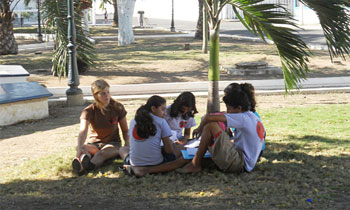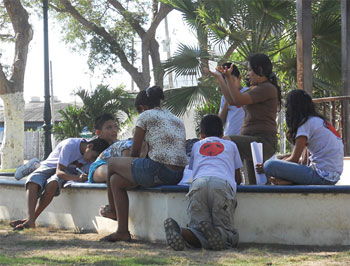Group B Professor: Nadine Flexhaug
Assistant: Roberto Rodriguez
Planet Drum Foundation
Bioregional Education Program
Final Reports 2010
Photos below
Now half way through the Bioregionalism Educational Program, everyone is a little more familiar with what a bioregion consists of and how we as human beings can interact with the environment in a more sustainable way. Covering the theme of ¨suelo¨, (soil) in week 7, we talked to the kids about the different kinds of soil and how their distinct characteristics allow certain plants to grow and flourish while others need a different type of soil to survive. We also explained the process of compost. Most of the Students hadn’t even heard of the term before, and were a little lost as to how the process works. When I began to explain that you first need to separate the garbage between organic and inorganic, I asked them what some examples of inorganic garbage are. One student, Recalde Alejandro, responded with ¨plastic bags.¨ I immediately explained to them the difference between organic and inorganic garbage and everyone began listing examples of organic like, fruit peels, seeds, vegetable leftovers, coffee grounds, etc. The students were surprised when we told them you can create a compost in your own backyard and return the organic waste back into the soil instead of throwing it out with the rest of the garbage. We talked about how much of the garbage in Bahia is organic and what a big difference it would make if we all made the effort to recycle our own organic waste.

That following Friday we went on a fieldtrip to one of Planet Drum’s revegetation sites. Clay, the coordinator of the program came along and served as our guide. He led us along a trail through the forest and pointed out some native plants, testing the student’s knowledge. Mariuxy, who is always full of energy and intrigued by every new thing she learns about the environment, quickly spotted the Palo Santo tree and was so fascinated by it’s aroma that she began collecting fallen branches and distributing them to everyone, so they could take it home and burn to keep the mosquitoes away.
The following week we covered ¨flora¨ and went to visit Planet Drum’s greenhouse. Orlando, a Planet Drum employee met us there and explained to the students about the greenhouse and the plants which were planted inside. He was great at motivating the kids and after explaining how they were going to transplant the little trees into the plastic bottle pots, he pointed out to them the work of the other two groups which had already been there. Each group had an area full of planted trees, and the kids began to count the number of completed transplants in each group. Then, very determined, they started working together to transplant as many trees as possible. Rosa, Mariuxy, Samantha and Ariana planted the plants, Recalde and Jean Benavidez made the holes to put them in and the others went collecting bottles and arranging the planted trees. They finished with the least time and the most trees planted in all three groups. They were so satisfied with their work, they wanted to take a tree home and care for it.
On the 9th week, we talked about birds – The different species, habitats, food, migration and the threats to their habitats. The following Friday they went on a field trip to la Isla Corazon. Click here to see photos of the trip to Isla Corazon. I didn’t attend this field trip because I had to give exams in the University, but the kids informed me of the trip the following week and since that day it has been their favorite field trip.

On the 10th week, we covered the theme Marine ecosystem. I told the kids about how the currents change in summer and winter, and how this affects the whole marine ecosystem – the marine animals and fish that live in the ecosystem and the birds that feed off the fish. I asked them to name the different types of contamination in the oceans, rivers and lakes, and what they can change to no longer contaminate. Then all three groups went walking to Bellaca beach. I quizzed the students along the way asking them about the types of fauna that live in the ocean in Bahia and about the changes in the water between summer and winter. When we arrived, we set up goal posts, played soccer, Frisbee, swam, etc.
The next week was the final test. We split the kids into two groups, Roberto with one group and I the other. We each reviewed each theme with the students, focusing on key points and helping them remember by referring to the examples we had seen on the field trips. The students confidently wrote their tests, handed them in and we went to the beach.
The last week we prepared for the open house. We have decided to make recycled paper. Mariuxy brought the molds and nets, Cagua brought the blender and the rest brought all kinds of old, used sheets of paper. I put them to work ripping the papers into very small pieces and sorting them according to the color. We are now waiting to hear when the open house will be, as it has been rescheduled, to finish the project and present it to the public.
The closing of the program was held on the 23rd of July, on the beach. Click here for pictures from the Closing Ceremony. All three groups, the professors, assistants, coordinator, etc. met and played on the beach. We had a barbeque and each group had 2 or 3 representatives share with everyone what they had learned and what was their favorite part of the program. We gave prizes to the best students in each group – the best assistance, the student who participated the most, etc.
Now the program is at a close, with the open house pending. The students have asked when we are having more classes and are waiting patiently for the day of the open house.

Reader Interactions